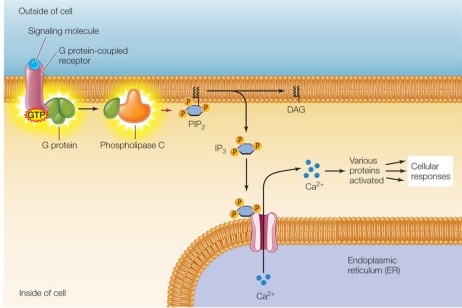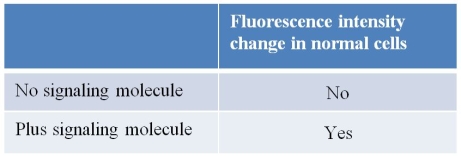Refer to the figure and table below. 
 A researcher treated mouse kidney cells growing in culture so that they took up a fluorescent dye into their cytosols without losing viability.(This dye undergoes a change in fluorescence intensity upon binding calcium ions.) The treated cells were then incubated with and without a compound thought to act as a signaling molecule, and the cells were observed for changes in fluorescence.The researcher hypothesizes that the signaling molecule functions according to the pathway shown in the diagram above.As a next step, the researcher wants to acquire evidence that IP3 is involved in this pathway.Which procedure will provide needed evidence about IP3 as the entire experiment is repeated?
A researcher treated mouse kidney cells growing in culture so that they took up a fluorescent dye into their cytosols without losing viability.(This dye undergoes a change in fluorescence intensity upon binding calcium ions.) The treated cells were then incubated with and without a compound thought to act as a signaling molecule, and the cells were observed for changes in fluorescence.The researcher hypothesizes that the signaling molecule functions according to the pathway shown in the diagram above.As a next step, the researcher wants to acquire evidence that IP3 is involved in this pathway.Which procedure will provide needed evidence about IP3 as the entire experiment is repeated?
A) Using mouse kidney cells containing a mutation that knocks out GTP binding by G protein
B) Using mouse kidney cells containing a mutation that knocks out phospholipase C
C) Adding a calcium channel inhibitor during all trials
D) Replacing the signaling molecule with an agonist molecule
E) Replacing the signaling molecule with IP3
Correct Answer:
Verified
Q67: Refer to the table below, which lists
Q68: Refer to the graph below. 
Q69: A transcription factor located in the cytoplasm
Q70: Which statement about gap junctions is true?
A)
Q71: The figure below shows the oxytocin signal
Q73: Which statement about the abnormal form of
Q74: Which represents the correct ordering from lowest
Q75: Which statement about nitric oxide is true?
A)
Q76: Refer to the graphs below.
Q77: The G protein-mediated cascade stimulated by epinephrine
Unlock this Answer For Free Now!
View this answer and more for free by performing one of the following actions

Scan the QR code to install the App and get 2 free unlocks

Unlock quizzes for free by uploading documents